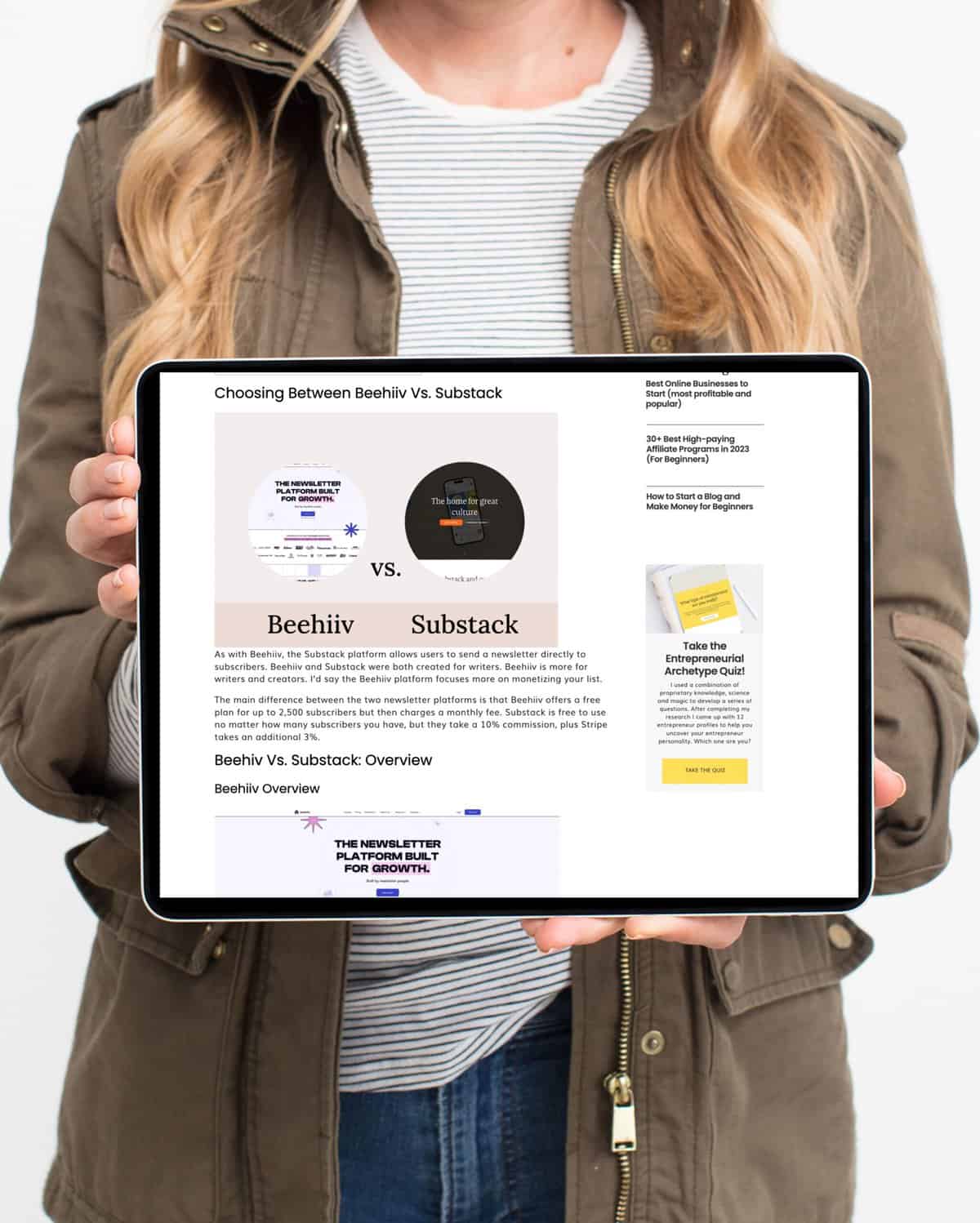Learn the 7 Best Ways to Promote Affiliate Links
This page may contain affiliate links. Please read my disclosure for more information.
Affiliate marketing has quickly become one of the most popular ways to make money online. Whether you’re a blogger, social media influencer, or website owner, affiliate marketing offers a lucrative opportunity to earn commissions by learning how to promote affiliate links, products, and services.
With affiliate marketing, you can earn a passive income without having to create or sell your own products. All you need to do is promote your unique affiliate link and earn a commission on every sale made through that link.
Affiliate marketing is, however, not 100% passive because you can only make a commission if you promote your affiliate links.
In this post, we’ll discuss how to promote affiliate links, how to find an affiliate program to join, how affiliate programs work, how to use affiliate links, how to track affiliate links, how to disclose affiliate links, and what to avoid with affiliate links.
How do I find an affiliate program to join?

As an affiliate marketer, there are several places to look for affiliate programs.
1. Products You Use
Start by looking at the products you currently use. Search directly on the brands website. Look for a link in the menu or footer that says “affiliate program” or “partner program”.
2. Google Search
You can also do a google search by typing into google “the brands name” + “affiliate program” or “your niche” + “affiliate program”.
3. Affiliate Directories
Search affiliate networks like impact.com, ShareASale, flexoffers, CJ Affiliates or AWIN.
4. Lists posts
Look for blog posts in your niche that list the best affiliate programs. For example, 30+ Best High-paying Affiliate Programs in 2023 (For Beginners).
5. Find competing products
Another way to find affiliate products to promote is to look at the competitors of the current products you’re promoting.
6. Promote your own products
In addition to learning how to promote affiliate links its important to also learn how to promote your own products with affiliate marketing. To start, you’ll need to create an affiliate program or join an existing affiliate network. This will allow you to create unique affiliate links for your products and track the performance of your affiliates.
1. Set a commission rate
Decide on a commission rate that you’ll pay your affiliates for each sale they generate through their affiliate links. This rate should be competitive with other affiliate programs in your niche but also sustainable for your business.
2. Recruit Affiliates
Reach out to bloggers, influencers, and other content creators in your niche to recruit affiliates. Provide them with all the necessary information, such as commission rates, affiliate links, and promotional materials.
3. Provide Promotional Materials
Create high-quality promotional materials, such as banners, images, and product descriptions, that your affiliates can use to promote your products. Make sure these materials are in line with your brand identity and messaging.
4. Offer Incentives
Offer incentives for affiliates who generate a certain number of sales or reach specific performance goals. This can motivate your affiliates to promote your products more actively.
5. Promote Your Affiliate Program
Promote your affiliate program on your website, social media channels, and other marketing channels to attract more affiliates.
How do affiliate programs work?

1. Affiliate link placement
You embed affiliate links on your blog, website or social media platforms for potential customers.
2. The customer clicks your affiliate link
The customer clicks your affiliate link and is sent to the XYZ brand’s website.
3. The affiliate link is recorded
The customer makes a purchase on the brand’s website, and the affiliate program or network records the transaction and details.
4. Affiliate sales
The customer made a purchase through your affiliate link, which was recorded, and now you will get paid a commission based on the terms and conditions of that specific affiliate program.
How to use affiliate links?

When promoting affiliate links, it’s important to choose affiliate products you use, love, and understand yourself.
- Choose an affiliate product that’s relevant and a good fit for your content and audience.
- Review the payout and commission structure and select an affiliate product that will be lucrative for you. It’ll take the same amount of time and work to promote a $2 product vs. a $200 product. Your commission will, however, be different.
- Choose to promote affiliate links and products that are helpful to your audience and in demand.
- Put affiliate links throughout your website. For example, in a blog post, product reviews, a landing page, a resource page, and in video content such as in the descriptions of your youtube videos.
- Promote affiliate links in your email sequences and newsletters.
- Use your social media channels as a platform to promote affiliate links.
How to track affiliate links

Tracking affiliate links is an important part of affiliate marketing. It allows you to monitor the performance of your affiliate links, track clicks, conversions, and earnings, and optimize your promotional strategies to maximize your profits. Here are some ways to track affiliate links:
1. Use Affiliate Tracking Tools
Most affiliate programs provide tracking tools that allow you to track your clicks, conversions, and earnings. These tools are usually available on your affiliate dashboard or account.
2. Use URL Shorteners
URL shorteners like bit.ly, goo.gl, and ow.ly allow you to create shortened URLs for your affiliate links. These services also provide tracking and analytics features, allowing you to track clicks and other metrics for your links.
3. Use Google Analytics
If you have a website or blog, you can use Google Analytics to track clicks and conversions for your affiliate links. Simply create a custom campaign for your affiliate links and use unique tracking codes to monitor performance.
4. Use WordPress Plugins
If you’re using WordPress to manage your website or blog, there are many plugins available that can help you track your affiliate links. Some popular options include ThirstyAffiliates, Pretty Links, and Easy Affiliate Links.
5. Track Conversions
To track conversions, you can use conversion tracking pixels or codes provided by the affiliate program or network you are working with. This allows you to track when a user makes a purchase or takes a desired action after clicking on your affiliate link.
How to disclose affiliate links

As an affiliate marketer, it’s important to disclose your affiliate links when promoting products or services through your website or social media. Here are some ways to do it:
1. Use clear and obvious language
Make sure your readers know that you are promoting affiliate products. You can use phrases like “affiliate link,” “affiliate disclosure,” “commissioned link,” or “I earn a commission from purchases made through this link.”
2. Place the disclosure near the affiliate link
Make sure the disclosure is placed near the affiliate link so that readers can easily see it. You can put it above, below, or next to the link. I’d recommend always putting it at the top of a blog post.
3. Use a disclosure policy page
You can create a separate page on your website that explains your affiliate marketing practices and how you disclose affiliate links.
4. Use hashtags
You can use hashtags like #ad, #sponsored, #affiliate, or #commissioned to disclose your affiliate links on social media platforms.
Remember, being transparent about your affiliate links builds trust with your audience and helps you comply with legal requirements. So, make sure to disclose your affiliate links clearly and prominently.
What to avoid with affiliate links

While affiliate marketing can be a great way to earn a passive income, there are also some common pitfalls and mistakes to avoid when it comes to affiliate links. Here are some things to avoid with affiliate links:
1. Misleading or deceptive promotion
Avoid using misleading or deceptive tactics to promote your affiliate links, such as false claims or exaggerations about the products or services you are promoting. This can damage your reputation and credibility, and may even lead to legal consequences.
2. Spamming
Avoid spamming your affiliate links to your audience through email, social media, or other channels. This can come across as intrusive and annoying, and may lead to your audience ignoring or unfollowing you.
3. Promoting low-quality or irrelevant products
Avoid promoting products that are low-quality or irrelevant to your audience. This can lead to low conversion rates and may even damage your reputation as a trusted source of information and recommendations.
4. Not disclosing affiliate relationships
It is important to disclose your affiliate relationships to your audience. Failure to do so can damage your credibility and may even violate legal requirements.
5. Over-promoting
Avoid over-promoting your affiliate links, as this can come across as pushy and may lead to your audience losing trust in you. Instead, focus on providing valuable content and only promote products or services that you genuinely believe in and that will be helpful to your audience.
By avoiding these common mistakes, you can build a successful affiliate marketing strategy that promotes your links effectively while also maintaining your credibility and trust with your audience.
Summary
In conclusion, affiliate marketing provides a great opportunity to earn a passive income by promoting products and services online.
By following the tips outlined in this post, such as finding affiliate programs to join, promoting your own products with affiliate marketing, using and tracking affiliate links, disclosing your affiliate relationships, and avoiding common pitfalls, you can successfully promote your affiliate links and increase your earnings.
Remember to always prioritize providing value to your audience and promoting products that are relevant and helpful to them. With dedication and effort, you can build a successful affiliate marketing strategy and achieve your financial goals.







+ show Comments
- Hide Comments
add a comment